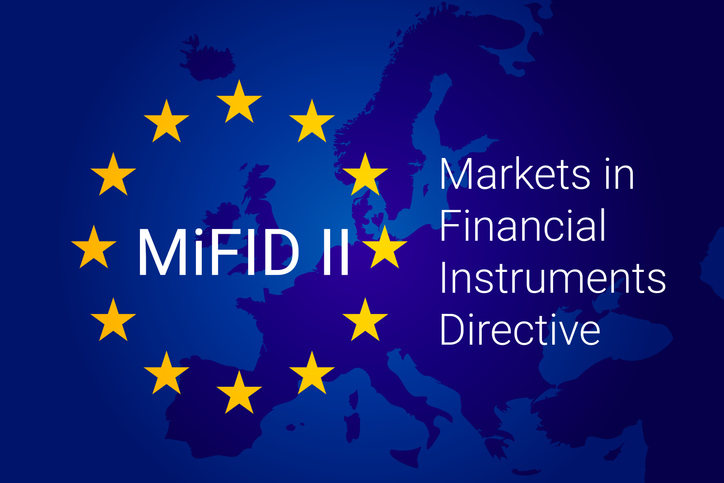The key requirements of MiFID II/MiFIR
The introduction of the MiFID II regime was not intended as a cosmetic fix to the European financial markets regulatory environment.
Rather, it marked the arrival of a whole new trading and investor protection landscape whose impact will be felt globally as well as within Europe due to the many cross-border implications.
MiFID II increased the original Directive’s scope beyond equities and across nearly all asset classes.
This, combined with the introduction of new trading venues and a raft of requirements around pre- and post-trade transparency, investor protection, and corporate governance, means that the effects of MiFID II are so profound as to challenge the very business models of many market participants.

Market structure
Organized trading facilities (OTFs)
A fundamental objective of MIFID II is to encourage a shift away from bilateral over-the-counter trading to regulated trading platforms.
In pursuit of this objective, a new category of trading venue was established in order to capture the maximum of previously unregulated trades. This venue is known as an organized trading facility, or OTF.
OTFs operate alongside existing trading venues such as regulated markets and multilateral trading facilities.
However, unlike regulated markets and MTFs, the scope of instruments traded on OTFs is restricted to non-equity instruments – namely bonds, structured finance products, emissions allowances, and derivatives.
Systematic internalizers (SIs)
Systematic internalizers are institutions that deal on their own account by executing client orders outside a trading venue. The SI regime was introduced by MiFID I, but didn’t take off as envisaged, so MiFID II extended its scope.
Significantly, MiFID II specifies quantifiable definitions for “frequent and systematic” and “substantial,” based on trading volumes.
Derivative trading obligations
One of the most significant changes brought about by MiFID II relates to derivative markets and the shift from bilateral OTC markets to multilateral trading.
Transactions in any class of derivatives that are subject to the clearing obligation under the European Market Infrastructure Regulation (EMIR) are required to take place on an RM, MTF, or OTF.
Market access
MiFID II aimed to increase competition in the trading and clearing of derivatives. To this end, firms can select their own central counterparty (CCP) instead of having to use that of the trading venue.

Market transparency
Pre-trade transparency
MiFID II extended the existing pre-trade transparency regime to cover equity-like and nonequity instruments, as well as offering waivers to transparency requirements.
Post-trade transparency
MiFID II aims to address the fragmentation of equity markets across the EU and, to this end, promotes an appropriate data reporting regime that supports data services providers.
This covers:
- Timeliness
- Consolidated tape providers (CTPs)
- Approved Publication Arrangement (APA)
- Time synchronization

Investor protection
Product governance
As part of its investor protection framework, MiFID II introduced extensive product governance requirements for both manufacturers and distributors of investment products and services.
The definition of a manufacturer is designed to capture a broad range of firms as it includes those that create, develop, issue, or design financial instruments.
Distributors are investment firms that offer, recommend, or sell financial instruments and services to clients.
Investment advice
The key MiFID II requirements in relation to investment advice are:
Independence
Before an investment firm provides investment advice, it must inform the client whether the advice is being provided on an independent basis.
Costs
An investment firm must inform its client of all relevant, aggregated costs and how the client may pay such costs.
Packages of products/services
When an investment firm offers a package of products or services, the client must be informed:
- Whether it is possible to buy the components separately
- What the costs and charges for each component are
- How the interaction of the component parts affects overall risk
Knowledge and competence
Investment firms must ensure, and be able to demonstrate to regulators on request, that their investment advisors possess the necessary knowledge and competence to meet their obligations.
Suitability
MIFID II strengthened the provisions related to the suitability and appropriateness of investments, particularly for non-professional (or retail) clients.
A suitability test must be conducted by firms when providing investment advice, whether independent or not, and also when providing portfolio management services.
Suitability and sustainability
Under its MiFID II Delegated Regulation, which came into force on August 2, 2022, the EU introduced additional suitability requirements. Investment firms must capture their clients’ sustainability preferences under their suitability assessment procedures and policies.
Suitability reports
An investment firm must provide retail clients with a suitability report on a product recommendation. Suitability obligations also apply when issuing a recommendation to a client to buy, hold, sell, subscribe for, exchange, redeem, or underwrite financial instruments.
Appropriateness
When providing investment services not requiring advice, such as execution-only services, suitability requirements do not apply.
In the case of nonprofessional clients, however, the firm must assess whether the financial instrument or service is appropriate for the client.
Inducements
MiFID II requires investment firms to take all appropriate steps to identify and prevent or manage conflicts of interest that arise in the course of providing any investment and ancillary services.
Investment research
MiFID II unbundles the purchase of investment research from execution services, thereby seeking to end the practice of “soft commissions” where the purchase of investment research ties the investment firm to a particular broker.
Best execution
Under the original MiFID rules, investment firms were required to take “reasonable steps” to obtain the best possible outcome for their clients. MiFID II intensifies this best execution obligation by replacing the term “reasonable steps” with “all sufficient steps.”
Conduct of business: product coverage
MiFID II narrows the list of products that may be sold on an execution-only basis. It extends the conduct of business rules to new asset classes.

Transaction reporting
Transaction reporting is the means by which investment firms provide reports to regulators containing the details of each transaction they execute, typically no later than close of business the following day.
Other key requirements
Commodity derivatives: limits and trading restrictions
One of the express objectives of MiFID II is to discourage speculation on commodities in order to prevent artificial and substantial rises in the prices of basic products such as agricultural goods. This speculation is restricted by introducing a harmonized EU system setting limits on the positions held in commodity derivatives by both market members and participants.
High frequency trading
While HFT plays an important role in providing liquidity (and is thus consistent with the objectives of MiFID), it brings with it certain risks. These include the potential for market crashes (and high investor losses) due to errant algorithms and the amplification of systemic risk.
Internal control and governance
Investment firms must ensure that both the management body as a whole as well as its individual members meet certain standards. When assessing the collective suitability of the management body, firms should consider specific areas of knowledge and fields of expertise such as the firm’s material activities and risk management.
***
This article was extracted from the MiFID II/MiFIR – Key Requirements tutorial in Know-How, the world’s leading digital learning library for finance.
If you would like to learn how you can use Know-How to teach your workforce about this legislation, please click here.

